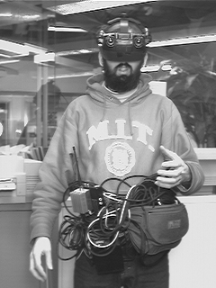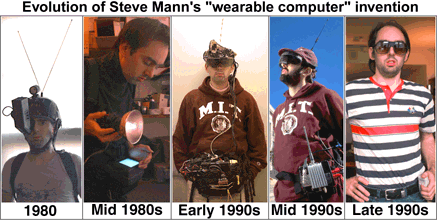

Put yourself in my shoes and see the world from my perspective. Pictured above is an old communications antenna array on copper-lined helmet, not presently used. Now I use the ``visualfilter'' (pictured below). Through the VisualFilter, I perceive my surroundings by "viewing" rather than seeing, and this also means that another person can "view" the world exactly as I do. Closing the loop in this way (e.g. using the visual filter explained below) enables me to record exactly what I experience, as opposed to merely putting a camera on my head (above picture) in the style of Letterman, 60 Minutes, or the like, where the camera would not necessarily record exactly what the viewer was looking at.
Sending visual information from my head-mounted cameras to one or more remote processors (like some SGI Reality Engines on the Internet) and then receiving a processed version of the visual information back at my head mounted display, gives rise to what I call the `Visual Filter'. While I can't put a Reality Engine in my backpack, I can still pipe my visual world through one or more such computers and get the same effect. A science fiction writer might envision implanting a computer anywhere in the world between the eye and the brain, but this is a long way off. Right now I'll live with my bulky communications equipment.
Simple processing like turning the image upside-down (like the upside-down prisms that people used to use to see if someone could learn to live in an upside-down world) would be possible, but of course there are far more interesting possibilities.
 (like this ceiling dome of wine-dark opacity).
(like this ceiling dome of wine-dark opacity).
Many advocates of surveillance have dismissed the Orwellian aspects of video surveillance, by suggesting that it just makes the world more like a small town, but if we compare surveillance and small towns on a `symmetry axis' we see that they are quite different. In fact, wearable cameras are more apt to make the world like a small town than surveillance cameras.
What is and is not a violation of privacy? Perhaps the principle of "self ownership" could serve as a guide to answering this question.
Unfortunately, video surveillance is growing out of control, and one almost wonders if privacy is a lost cause. If it is a lost cause, perhaps we can at least have a little bit of fairness on the Surveillance Superhighway. The concept of privacy in cyberspace is quite real and achievable, but in physical space, perhaps symmetry is a more attainable goal.
--James Baldwin
Other links to Wireless WearCam
© Copyright notice (That circle-C is ASCII 251 in case you were wondering.)